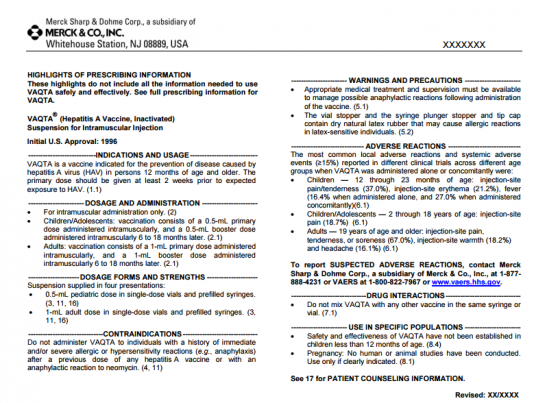
Vaqta: Hepatitis A Vaccine, Inactivated): patient information, prescribing information, ingredients, manufacturer, adverse reactions and side effects
Saturday, April 08, 2017 by Gregory Van Dyke
http://www.naturalnewsreference.com/2017-04-08-vaqta-hepatitis-a-vaccine-inactivated-patient-information-prescribing-information-ingredients-manufacturer-adverse-reactions-and-side-effects.html

HIGHLIGHTS OF PRESCRIBING INFORMATION
These highlights do not include all the information needed to use VAQTA safely and effectively. See full prescribing information for VAQTA.
See full insert sheet at this link at the Natural News Reference website.
VAQTA® (Hepatitis A Vaccine, Inactivated)
Suspension for Intramuscular Injection
Initial U.S. Approval: 1996
INGREDIENTS AND EXCIPIENTS
VAQTA is an inactivated whole virus vaccine derived from hepatitis A virus grown in cell culture in human MRC-5 diploid fibroblasts. It contains inactivated virus of a strain which was originally derived by further serial passage of a proven attenuated strain. The virus is grown, harvested, purified by a combination of physical and high performance liquid chromatographic techniques developed at the Merck Research Laboratories, formalin inactivated, and then adsorbed onto amorphous aluminum hydroxyphosphate sulfate.
VAQTA is a sterile suspension for intramuscular injection. One milliliter of the vaccine contains approximately 50U of hepatitis A virus antigen, which is purified and formulated without a preservative. Within the limits of current assay variability, the 50U dose of VAQTA contains less than 0.1 mcg of nonviral protein, less than 4 x 10–6 mcg of DNA, less than 10–4 mcg of bovine albumin, and less than 0.8 mcg of formaldehyde. Other process chemical residuals are less than 10 parts per billion (ppb), including neomycin.
Each 0.5-mL pediatric dose contains 25U of hepatitis A virus antigen and adsorbed onto approximately 0.225 mg of aluminum provided as amorphous aluminum hydroxyphosphate sulfate, and 35 mcg of sodium borate as a pH stabilizer, in 0.9% sodium chloride. Each 1-mL adult dose contains 50U of hepatitis A virus antigen and adsorbed onto approximately 0.45 mg of aluminum provided as amorphous aluminum hydroxyphosphate sulfate, and 70 mcg of sodium borate as a pH stabilizer, in 0.9% sodium chloride.
INDICATIONS AND USAGE
VAQTA is a vaccine indicated for the prevention of disease caused by hepatitis A virus (HAV) in persons 12 months of age and older. The primary dose should be given at least 2 weeks prior to expected exposure to HAV. (1.1)
DOSAGE AND ADMINISTRATION
– For intramuscular administration only. (2)
– Children/Adolescents: vaccination consists of a 0.5-mL primary dose administered intramuscularly, and a 0.5-mL booster dose administered intramuscularly 6 to 18 months later. (2.1)
– Adults: vaccination consists of a 1-mL primary dose administered intramuscularly, and a 1-mL booster dose administered intramuscularly 6 to 18 months later. (2.1)
DOSAGE FORMS AND STRENGTHS
Suspension supplied in four presentations:
– 0.5-mL pediatric dose in single-dose vials and prefilled syringes. (3, 11, 16)
– 1-mL adult dose in single-dose vials and prefilled syringes. (3, 11, 16)
CONTRAINDICATIONS
Do not administer VAQTA to individuals with a history of immediate and/or severe allergic or hypersensitivity reactions (e.g., anaphylaxis) after a previous dose of any hepatitis A vaccine or with an anaphylactic reaction to neomycin. (4, 11)
WARNINGS AND PRECAUTIONS
Appropriate medical treatment and supervision must be available to manage possible anaphylactic reactions following administration of the vaccine. (5.1)
The vial stopper and the syringe plunger stopper and tip cap contain dry natural latex rubber that may cause allergic reactions in latex-sensitive individuals. (5.2)
ADVERSE REACTIONS
The most common local adverse reactions and systemic adverse events (≥15%) reported in different clinical trials across different age groups when VAQTA was administered alone or concomitantly were:
Children — 12 through 23 months of age: injection-site pain/tenderness (37.0%), injection-site erythema (21.2%), fever (16.4% when administered alone, and 27.0% when administered concomitantly)(6.1)
Children/Adolescents — 2 through 18 years of age: injection-site pain (18.7%) (6.1)
Adults — 19 years of age and older: injection-site pain, tenderness, or soreness (67.0%), injection-site warmth (18.2%) and headache (16.1%) (6.1)
To report SUSPECTED ADVERSE REACTIONS, contact Merck Sharp & Dohme Corp., a subsidiary of Merck & Co., Inc., at 1-877- 888-4231 or VAERS at 1-800-822-7967 or www.vaers.hhs.gov.
DRUG INTERACTIONS
Do not mix VAQTA with any other vaccine in the same syringe or vial. (7.1)
USE IN SPECIFIC POPULATIONS
Pregnancy
Pregnancy Category C: Animal reproduction studies have not been conducted with VAQTA. It is also not known whether VAQTA can cause fetal harm when administered to a pregnant woman or can affect reproduction capacity. VAQTA should be given to a pregnant woman only if clearly needed.
Pediatric Use
The safety of VAQTA has been evaluated in 4374 children 12 through 23 months of age, and 2615 children/adolescents 2 through 18 years of age who received at least one 25U dose of VAQTA [see Adverse Reactions (6) and Dosage and Administration (2)]. Safety and effectiveness in infants below 12 months of age have not been established.
Geriatric Use
In the post-marketing observational safety study which included 42,110 persons who received VAQTA [see Adverse Reactions (6.2)], 4769 persons were 65 years of age or older and 1073 persons were 75 years of age or older. There were no adverse events judged by the investigator to be vaccine-related in the geriatric study population. In other clinical studies, 68 subjects 65 years of age or older were vaccinated with VAQTA, 10 of whom were 75 years of age or older. No overall differences in safety and immunogenicity were observed between these subjects and younger subjects; however, greater sensitivity of some older individuals cannot be ruled out. Other reported clinical experience has not identified differences in responses between the elderly and younger subjects.
Immunocompromised Individuals
Immunocompromised persons may have a diminished immune response to VAQTA and may not be protected against HAV infection.
Revised: XX/XXXX
https://www.fda.gov/downloads/BiologicsBloodVaccines/Vaccines/ApprovedProducts/UCM110049.pdf
http://naturalnewsreference.com/vaccine-insert-sheets/Vaqta-Hepatitis-A-Vaccine-Inactivated.pdf
Tagged Under: Tags: dosage, ingredients, insert sheet, side effects, usage, vaqta, warnings





